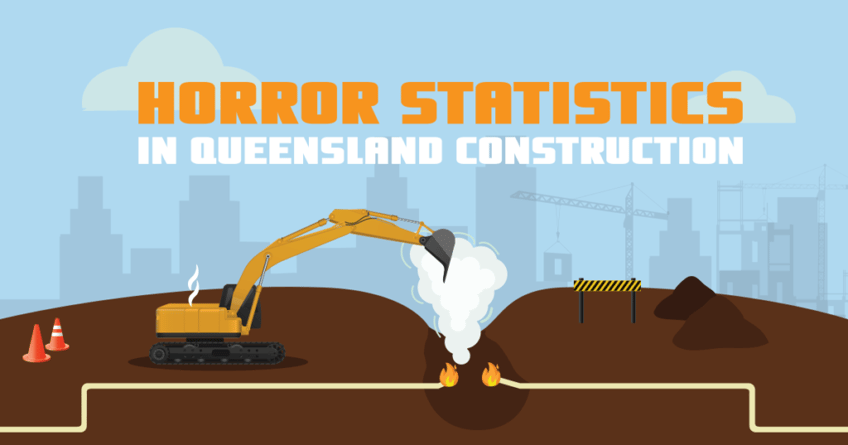21 May Article : Horror Statistics in Queensland Construction
In collaboration with Dial Before You Dig we’ve put together this list of horror events that happen to regularly in Australia. Avoid being a horror story, get the Dial Before You Dig Android or iPhone app

Horror Stat 1
Every year electrical distributors report up to 30 excavators contacting overhead and underground power lines each year.
Whether it be overhead or underground power lines, if accidental contact occurs the risks remain the same, a 30,000-degree arc can form and travel through your body and electrocute you or cause severe burns or serious injury (including amputations).
Horror Stat 2 & 3
A Dial Before You Dig Telecommunications member reports 20,000 strikes per year to their network, which resulted in damages of $20,000,000
Horror Stat 4
January to September this a total of 6,594 incidents have been voluntarily reported to DBYD. Of these 6,594 the majority of incidents were caused by mechanical excavation which could cause an incident in many ways, but the below were the most common;
- Water Main Flood
- Gas Pipe Explosion
- Telecommunication
- Contamination
STRIKING UNDERGROUND ASSETS
Striking underground assets may cause disruption of critical services to thousands of people. Incidents may also arise when damage to these underground assets is unreported and not repaired.
Some of the dangers when working near underground assets (SOURCE: WorkCover NSW: Work near underground assets guide 2007)
Gas
Damage to gas assets can cause gas escapes which may lead to fires or explosions if an ignition source is present. There are two types of leaks following damage to the asset:
- damage which causes an immediate escape. In this case, there is a risk to those working at the site
- damage which causes an escape sometime after the incident. This may be through damage which weakens the asset casing or the result of poor reinstatement practice. In this instance, the public is mainly at risk.
Electricity
an injury resulting from damage to live electricity cables is usually caused by electric shock or the explosive effects of arcing current and by the fire or flames which may follow when the sheath of a cable is penetrated by an object. Damage and injury may also occur if the cable is crushed or contact is made between the individual phases of a cable. The presence of gas or a mixture of gases in a trench could be ignited by an electrical charge or an electrical arc resulting in a fire or explosion, the severity of which depends on the gaseous mixture.
Gas can be present in the ground due to gas pipe damage or leakage, sewage pits, chemical reactions or leaching and the accumulation of airborne gases in low lying areas. Gas can also be introduced by the nature of the work being undertaken such as oxy-acetylene cutting or chemical grouting
Consideration should be given to conducting a risk assessment to determine if a trench or the work constitutes a confined space.
Petroleum or oil pipelines
The result of damaging these assets is similar to that of gas assets. However, there is the additional risk of significant environmental issues such as contamination of waterways.
Water pipes and sewers
Some pipelines transport water under high pressure. Some older water pipes are also made from asbestos cement. Damaged water pipes have great potential to affect other assets and structures, either directly or by washing away their supports ie thrust blocks
The main danger from sewer damage is the contamination of a broken water main or asset, damage to the environment or disease from exposure to sewage. Some sewer lines are high pressure. Toxic and explosive gases may also be present in both sewer lines and stormwater drains
Persons working on metallic water pipes are at risk of electric shock due to an electrical fault near a customer’s premises or a mains neutral fault in the street. Metallic water pipes are usually bonded to the electrical earthing system and are a path of low resistance. Stray electrical current will often flow through the bonded metallic water pipe. When the pipe is cut or disconnected, either side of the pipe could become live causing a person to receive a serious or fatal electric shock. The consumer is also at risk of an electric shock under the same circumstances.
Telecommunications
- Consequences could be the isolation of whole communities, disruption of interstate and international telecommunications, inability to contact emergency services, loss of telephone, mobile phone, data and television services
- Cables containing optical fibres carry light signals generated by Class 3B lasers that can cause injury to the eye. This infra-red beam is invisible to the naked eye and exposure to it should be avoided. Small optic fibre particles are capable of entering the bloodstream causing injury or death.
Pipelines containing hazardous substances and dangerous goods.
REFERENCE: McPherson, Sally. (2017). Horror Statistics in Australian Construction. [online] Blog.iseekplant.com.au. Available at: https://blog.iseekplant.com.au/blog/horror-statistics-queensland-construction-1 [Accessed 22 May 2019].









No Comments